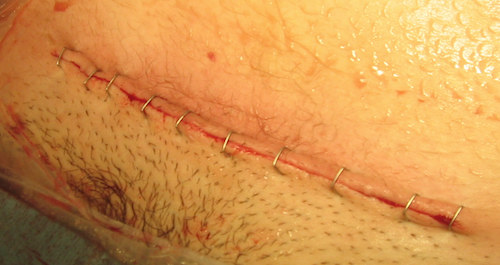Surgical Wound Classification
Lorenzo Romero, MD
The Operative Review of Surgery. 2023; 1:59-62.
Table of Contents
Surgical Wound Classification
History
- Originally Developed by the National Academy of Sciences and the National Research Council Cooperative Research Study in 1964 2
- Later Modified by the Centers for Disease Control (CDC) in 1982 3
Class I: Clean
- “These are uninfected operative wounds in which no inflammation is encountered and the respiratory, alimentary, genital, or uninfected urinary tracts are not entered. In addition, clean wounds are primarily closed, and if necessary, drained with closed drainage. Operative incisional wounds that follow nonpenetrating (blunt) trauma should be included in this category if they meet the criteria.” 3
- No Evidence of Infection
- No Inflammation
- Do Not Enter the Respiratory, Alimentary (GI), or Genitourinary (GU) Tracts
- Examples:
- Mastectomy
- Thyroidectomy
- Herniorrhaphy
- Nissen Fundoplication
- Splenectomy
- Vascular Procedures
- Cardiac Procedures
- Class ID: Otherwise Clean with a Prosthetic Graft (Mesh, Valve, etc.) 4
Class II: Clean-Contaminated
- “These are operative wounds in which the respiratory, alimentary, genital, or urinary tract is entered under controlled conditions and without unusual contamination. Specifically, operations involving the biliary tract, appendix, vagina, and oropharynx are included in this category, provided no evidence of infection or major break in technique is encountered.” 3
- Enters the Respiratory, Alimentary (GI), or Genitourinary (GU) Tracts
- Under Controlled Conditions with No Unusual Contamination
- No Evidence of Infection
- Enters the Respiratory, Alimentary (GI), or Genitourinary (GU) Tracts
- Examples:
- Bowel Resection
- Cholecystectomy
- Pancreatectomy
- Liver/Renal Transplant
- Nephrectomy
- Cesarean Section
Class III: Contaminated
- “These include open, fresh, accidental wounds, operations with major breaks in sterile technique or gross spillage from the gastrointestinal tract, and incisions in which acute, nonpurulent inflammation is encountered.” 3
- Gross GI Spillage
- Major Break in Sterile Technique
- Acute Non-Purulent Inflammation
- Examples:
- Bowel Resection with Gross Spillage
- Unsterile Instruments
- Open Cardiac Massage
- Gunshot Wound to the Abdomen
- Diverticulitis
- Appendectomy with Purulent Rupture
Class IV: Dirty
- “These include old traumatic wounds with retained devitalized tissue and those that involve existing clinical infection or perforated viscera. This definition suggests that the organisms causing postoperative infection were present in the operative field before the operation.” 3
- Through Existing Clinical Infection (Purulence)
- Perforated Viscera
- Old Wound with Retained Devitalized Tissue (Gangrene/Necrosis)
- Trauma with Devitalized Tissue
- Examples:
- Abscess Incision and Drainage
- Wound Debridements
- Perforated Bowel

Cesarean Section Wound 1
Interpretation
Poor Reliability
- Classification Scheme Has Low Inter-Rater Reliability 5,6
- Incorrect Classifications are Most Commonly Under-Classified 7
- Abdominal Wounds are the Most Likely to Be Incorrectly Classified as Clean Wounds 8
- Do Not Accurately Approximate Risk in Pediatrics 9
Risk of Surgical Site Infection (SSI) – Classic Teaching 10
- Class I: 1-5%
- Most Common Source: The Patient Themselves
- Class II: 3-11%
- Class III: 10-17%
- Class IV: > 27%
Risk of Surgical Site Infection (SSI) – Newer NSQIP Data 11
- Newer Data Show Lower Rates in Modern Practice Than Previously Seen
| Class | Superficial SSI | Deep SSI | Organ/Space SSI |
| Class I | 1.76% | 0.54% | 0.28% |
| Class II | 3.94% | 0.86% | 1.87% |
| Class III | 4.75% | 1.31% | 2.55% |
| Class IV | 5.16% | 2.1% | 4.54% |
Preoperative Antibiotics
References
- Wikimedia Commons. (License: CC-BY-SA 3.0)
- Hart D, Postlethwait RW, Brown IW Jr, Smith WW, Johnson PA. Postoperative wound infections: a further report on ultraviolet irradiation with comments on the recent (1964) national research council cooperative study report. Ann Surg. 1968 May;167(5):728-43.
- Garner JS. CDC Guideline for Prevention of Surgical Wound Infections. CDC. 1982.
- Beilman GJ, Dunn DL. Surgical Infections. Schwarts’s Principles of Surgery, 10e. McGraw Hill. 2023.
- Sessums PO, Ledford CK, Sherman CE, Bosch W, Libertin CR, Brumble LM, Wilke BK. A Comparison of Interobserver Reliability Between Orthopedic Surgeons Using the Centers for Disease Control Surgical Wound Class Definitions. J Am Acad Orthop Surg. 2021 Dec 15;29(24):1068-1071.
- Wang-Chan A, Gingert C, Angst E, Hetzer FH. Clinical relevance and effect of surgical wound classification in appendicitis: Retrospective evaluation of wound classification discrepancies between surgeons, Swissnoso-trained infection control nurse, and histology as well as surgical site infection rates by wound class. J Surg Res. 2017 Jul;215:132-139.
- Ayat Abuihmoud, MS, CIC, Purisima Linchangco, MD, MPH, CIC, Elizabeth Wise, BSN, RN, CMSRN, Ashley Boldyga, BSHSM, Karen Nachman, MS, PhD, Belkys T Gomez, RN, MSN, Jorge P Parada, MD, MPH, 2136. Systematic Review of Surgical Wound Class Reveals Marked Service-Related Discrepancies and Can Improve Appropriateness of Classification Impacting the Expected Number of Infections and the Standardized Infection Ratio (SIR), Open Forum Infectious Diseases, Volume 5, Issue suppl_1, November 2018, Page S629.
- Stefanou A, Worden A, Kandagatla P, Reickert C, Rubinfeld I. Surgical Wound Misclassification to Clean From Clean-Contaminated in Common Abdominal Operations. J Surg Res. 2020 Feb;246:131-138.
- Gonzalez KW, Dalton BG, Kurtz B, Keirsey MC, Oyetunji TA, St Peter SD. Operative wound classification: an inaccurate measure of pediatric surgical morbidity. J Pediatr Surg. 2016 Nov;51(11):1900-1903.
- Garner JS. CDC guideline for prevention of surgical wound infections, 1985. Supersedes guideline for prevention of surgical wound infections published in 1982. (Originally published in November 1985). Revised. Infect Control. 1986 Mar;7(3):193-200.
- Ortega G, Rhee DS, Papandria DJ, Yang J, Ibrahim AM, Shore AD, Makary MA, Abdullah F. An evaluation of surgical site infections by wound classification system using the ACS-NSQIP. J Surg Res. 2012 May 1;174(1):33-8.